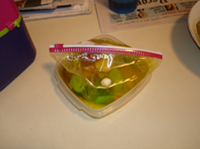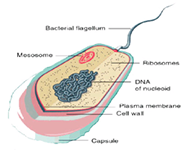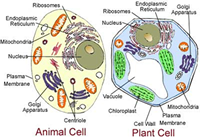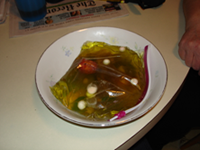
The smallest and simplest unit of life is called a cell. Learn what is inside a cell and the difference between plant and animal cells.
Age Appropriateness
6-8 years old
INTRODUCTION
The smallest and simplest unit of life is called a cell. Cells are divided into two types of cells based upon their complexity. The simplest cells are called prokaryotic cells. Bacteria are examples of a prokaryotic cells and a picture of one bacterium can be found below. All the different parts of a cell are called organelles and each serve a specific purpose. Notice that the prokaryotic cell has very few organelles.
The more complex cells in plants and animals are called eukaryotic cells. These cells contain many organelles and a membrane surrounds many of these. A membrane's function is to separate the organelle from the area around it. If an organelle were a piece of fruit, the membrane would be the skin of the fruit.
 If you notice in the pictures of the animal cell and plant cell below, they do not look exactly alike! Many of the organelles are the same in both the plant and animal cell and perform similar functions. However, the plant cell has some organelles that the animal cell does not, and the animal cell has some organelles that the plant cell does not have.
If you notice in the pictures of the animal cell and plant cell below, they do not look exactly alike! Many of the organelles are the same in both the plant and animal cell and perform similar functions. However, the plant cell has some organelles that the animal cell does not, and the animal cell has some organelles that the plant cell does not have.
In the activity we will:
- Learn the different organelles that make up a cell.
- Learn how to tell the difference between plant and animal cells.
 Materials
Materials
- 2 sandwich sized Ziploc bags
- 1 hard Tupperware sandwich sized box
- 2 boxes of light colored Jell-O (lemon is suggested)
- Fruit or candy to represent the various organelles of the cell. Use the shopping list at the end of this activity to guide you.
**Remember to use fruits, vegetables, or candy that is available and that YOU like! If you make sure to use ingredients that you think go together and are yummy then you can eat your cell at the end!**
Safety
- Be careful while handling hot water. Ask an adult to help you if necessary.
Pre-Activity
Examine this list of the organelles and each of their functions. Make sure to also take a look at the animal cell above to see what the organelle looks like. Then, after you think you have them memorized, complete the matching game on the last page. Try to think of clever ways and remember the functions of the organelles.
Organelles that Control the Cell:
Nucleus - The control center of the cell. It controls many of the chemical reactions that occur within the cytoplasm (defined below under miscellaneous). It also contains all the genetic material that determines the cell's characteristics.
Membrane - Surrounds many of the organelles of the cell (except for ribosomes in this list) and also the entire cell itself. The membrane that surrounds the entire cell is called the cellular membrane. It controls what goes in and out the cell or each of the organelles.
Organelles that Manufacture:
Ribosomes - Where proteins are created that the cell needs
Golgi Body - Finishes processing the proteins made by the ribosomes and "packages" them for transport to where they are needed in the cell.
Rough Endoplasmic Reticulum - It is "rough" since it has many ribosomes attached to it. It has two functions: one is to make more membrane and another is to make proteins, such as antibodies.
Smooth Endoplasmic Reticulum - It is "smooth" since it does not have ribosomes attached to it like the rough endoplasmic reticulum. In cells for different functions, it is responsible for making the proteins the cell needs to perform many functions.
Organelles that Breakdown:
Lysosomes - Digests the cell's food and wastes. The digested waste can then be used to make new parts of the cell.
Peroxisomes - Breaks down H2O2, a poisonous by-product of some cellular processes.
Vacuole - In plant cells, it is like a very large lyosome. It can break down old and damaged parts of the cell and also store chemicals that the cell needs.
Organelles that Make Energy:
Chloroplasts - Only in plant cells, these organelles convert solar energy to chemical energy that the cell can use.
Mitochondria - The energy center of the cell. Changes food energy into chemical energy the cell can use.
Miscellaneous:
Cytoplasm - The fluid of the cell that all the cell's organelles are contained within.
Activity
- Choose fruit, vegetables, or candy to represent each of the organelles. Use the graphic representations of the cells to guide your decisions of what best represents each of the organelles and also use the table at the end of this activity to help organize the materials.
- Test the plastic bags to ensure that they have no holes in them. Do this by either filling them with water or air and see if any leaks out.
- Follow the directions on two boxes of Jell-O to make it.
**Kids: Have an adult help you with this step since it may involve boiling water**
IF YOU BOIL WATER TO MAKE THE JELLO...ALLOW THE JELLO TO COOL IN THE FRIDGE OR FREEZER FOR A HALF HOUR OR MORE TO MAKE SURE YOU DO NOT BURN YOURSELF!!
First, begin to make the Plant cell. CAREFULLY pour the Jell-O into one of the Ziploc bags and seal it. The Ziploc bag represents the cell membrane and the Jell-O represents the cytoplasm.
 Place the Ziploc bag into the Tupperware sandwich box and place it into the fridge. The Tupperware sandwich box represents the cell wall of the plant cell.
Place the Ziploc bag into the Tupperware sandwich box and place it into the fridge. The Tupperware sandwich box represents the cell wall of the plant cell.- CAREFULLY pour the other box of made Jell-O into the other Ziploc bag and seal it. You have now made the beginnings of a model of an animal cell.Like in the plant cell, the Jell-O represents the cytoplasm while the Ziploc bag represents the cell membrane.
- Place this sandwich bag into the fridge. You may want to place it into a bowl to make sure that the Jell-O does not spill into the fridge.
- Allow the Jell-O of both cell models to cool in the fridge for approximately an hour. This will allow the Jell-O to gel slightly and cool.
- Add the fruit, vegetables, or candy that you chose for each of the organelles
- Allow the Jell-O to harden (this will take a couple of hours).
- You now have an edible model of both an animal and a plant cell. Enjoy!
- Answer the following questions:
- As you eat your cell try to name the function of each of the organelles!
- Which organelles are in both the animal and plant cells? Which are specific to the animal cell? Specific to the plant cell?
Extension Activity
You can also create a Jell-O model of a prokaryotic cell! Use the diagram in this activity as a guide.
Summary
All living things share at least one characteristic: they all contain cells. Although animals and plants look very different, they also both contain cells that are actually very similar in many ways. In this activity, you examined "typical" animal and plant cells, and many of the organelles are identical. However, there are a few organelles in both the typical animal and plant cells that are only in one or the other that perform functions that are unique to that type of cell.
Also, the functions listed for each of the organelles are very general. Cells are made to perform functions so some of the organelles are not in all cells. For example, a brain cell has different organelles and works differently than a blood cell. In plants, the cells in the stem will not look exactly like those in the leaves.
Resources
http://www.nelsonthornes.com/secondary/science/scinet/scinet/plants/cells/types.htm
Here you can find different types of plant cells:
http://web.jjay.cuny.edu/~acarpi/NSC/13-cells.htm
Here you can find more information about animal cells:
http://www.cellsalive.com/cells/animcell.htm
More information about animal cell organelles:
http://www.cellsalive.com/cells/plntcell.htm
More information about plant cell organelles:
Prokaryote cell diagrams: http://www.beyondbooks.com/lif71/4.asp
Eukaryote cell diagram: http://www.uic.edu/classes/bios/bios100/lecturesf04am/lect06.htm
Activity PDF: cello.pdf

